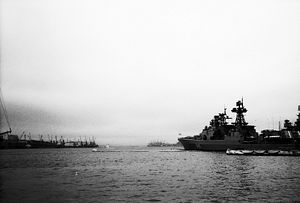In 2015, Russia has aimed to revive its expansive Far Eastern Federal District through unprecedented levels of cooperation with the Asia-Pacific region. In this three part series, we’ll explore those efforts. Part 1 looked at domestic initiatives and part 2 explored energy and trade. In part 3, we explore Russia’s growing influence in the Asian security sphere.
Defense trade with the Asia-Pacific has always been a key component of relations with the region. This year however, Russia has seen a more prominent role in transnational forums as diplomatic and security ties continue to evolve with China, Indonesia, Malaysia, India, and others. Within the context of simmering tensions in the Taiwan Strait, the South China Sea and the Korean peninsula, Russia has reoriented itself, capitalizing on increased demand from many Asian nations.
Expanding Security Presence in the Asia-Pacific
As renewed importance is attached to the Far East, security policy has been firmly entrenched in regional development. Primarily, President Vladimir Putin has sought to upgrade the aging Zvezda nuclear shipyards at Vladivostok, giving them a new lifespan of at least three decades. Russian Defense Minister Sergei Shoigu has stated that sailors should increase the frequency of training maneuvers instead of “sitting idly at the shipyard.” An investment program of up to $900 million was announced during September’s Eastern Economic Forum, which would also see the military facilities expanded to enable the construction of large-scale oil and gas transportation.
The joint Russian-Chinese military drills in the South China Sea conducted in August, featuring a vast array of military personnel and equipment, comprised the largest such exercises in history between the two nations. Featuring 22 warships, 20 aircraft, 40 armored vehicles, and over 500 marines, the drills encompassed ground, sea, and air operations and marked an increased presence of Russian naval power in the region. Similarly, the joint Russian-Indian INDRA operation has now become an annual fixture for the two navies. Exercises involving the Pacific Fleet, with live-firing, anti-air, and anti-submarine operations, were conducted off the coast of Vladivostok in the summer of 2014, while a new series of drills took place in December from the Indian port of Visakhapatnam. India is reported to have spent over $45 billion on Russian defense technology since the 1960s and shows no signs of slowing this trend.
With the Russian defense industry now worth $15 billion in exports each year according to Deputy Prime Minister Dmitry Rogozin, there have been signs of heightened demand in 2015. China has recently purchased 24 Sukhoi Su-35 fighter jets in a deal worth approximately $2 billion, while Indonesia, already operating the largest naval forces in Southeast Asia, has also signaled an investment in renewed air-defense technologies. The Indian Defense Council approved purchase of 48 Mi-17-V5 helicopters at the beginning of September in a deal worth $1 billion, in addition to their existing Russian-made arsenal.
Russian proposals of low-rate loans for military spending will allow countries such as Indonesia, Malaysia, and the Philippines — with whom a new agreement for defense cooperation was signed in August 2015 — the opportunity to upgrade their defense capabilities while bringing Russian influence closer to the region. The government’s active participation in the ASEAN Regional Forum in Kuala Lumpur in August, the multilateral Northeast Asia Peace and Cooperation Initiative in Seoul in October, and shortly after the Asian Defense and Security Conference in Bangkok in early November display Russian attempts to broaden the horizons of its eastward outlook.
Despite progress with many Asia-Pacific nations this year, ties with Japan have so far been limited due to the contentious issue of the Kuril Islands, also known as the Northern Territories. So far, constructive dialogue on the issue has not been forthcoming from either side, although the construction of Russian military facilities on the island chain in December will surely press the issue. The territories were taken by the Soviet Union in the aftermath of World War II, and are currently home to almost 20,000 people. Japan has protested recent visits to the islands — one prominent example being Prime Minister Dmitry Medvedev’s trip in August 2015 — but Tokyo still harbors hope for a strategic alliance in the Asia-Pacific, and is reluctant to further antagonize Russian ambitions. This highlights the fine balance between Russia’s emerging role as a regional mediator, while simultaneously becoming further embroiled in its own territorial disputes.
Pivotal Year for Russia’s East
Russia’s orientation in 2015 has been firmly focused on the emerging East — both within its own borders and with the dynamic and advancing economies of the Asia-Pacific region. The creation and initial success of the Eastern Economic Forum is a fitting snapshot of progress made in the last 12 months. Since the designation of new Priority Development Areas in December 2014, the Russian government has established links in over ten countries in the spheres of energy, security, diplomacy, and economic cooperation. By creating an inviting investment climate in the nine provinces making up the Far Eastern District, the hope is that foreign ventures will work in tandem with domestic policies boosting population growth, living standards, infrastructure capabilities and revival of the eastern ports. With growing Russian influence in the Asia-Pacific security sphere and the rise of national currency trade — removing the dominance of the dollar in the process — Putin will expect tangible results from the reorientation to the Far East in 2016.
Duncan Brown is a freelance writer based in Moscow, Russia. Follow him on Twitter @dncnbrwn.

































